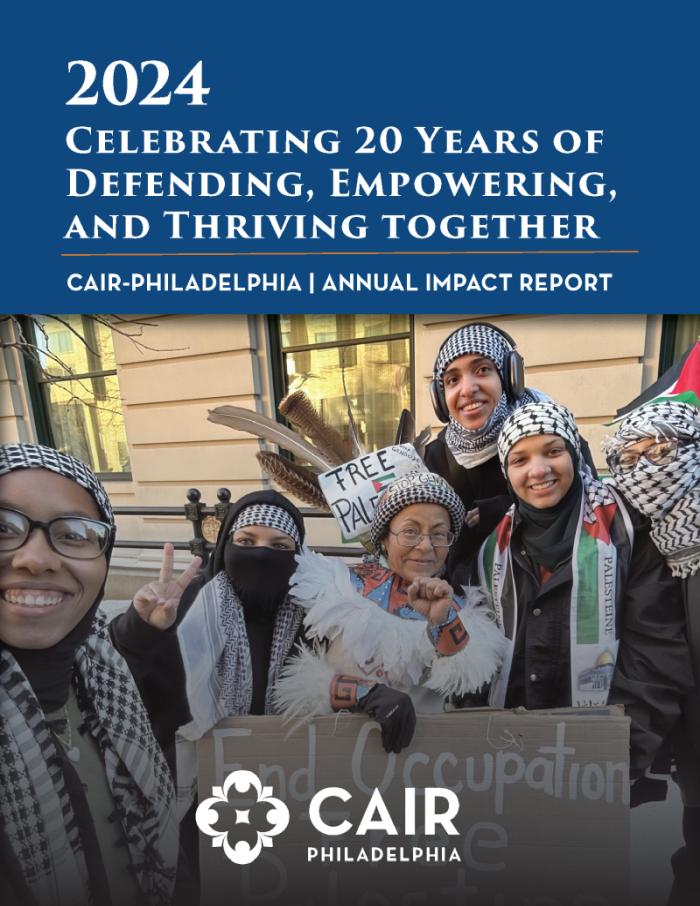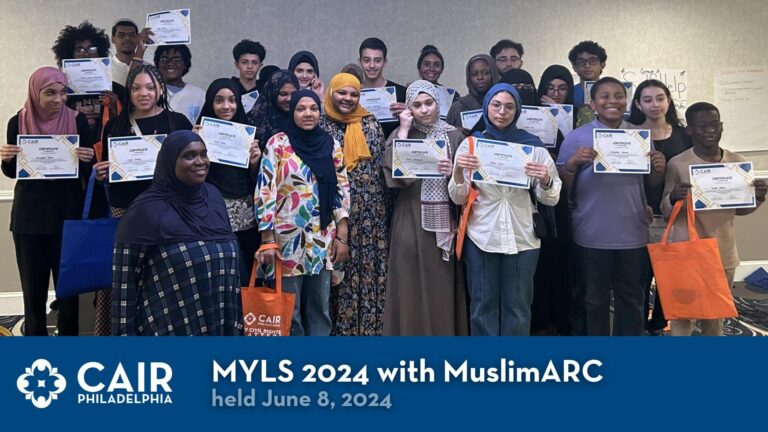by Ahmet Selim Tekelioglu
Published in Pennsylvania Legacies Magazine (Vol. 18, No. 1, Spring 2018)
DOWNLOAD PDF
The first slide that I show in my presentations on the Muslim experience in the United States is a photograph captioned “The Uniting Islamic Society of America, first convention, Phila, Aug. 18th 1943.” It’s a picture of a meeting, organized at the YMCA on 1724 Christian Street in Philadelphia, held by four early Muslim American organizations with a small but active and highly diverse following. This famous photograph is a witness to the dynamism and deep roots of the Muslim presence in Philadelphia—the city home to one of the densest Muslim populations in the United States. My work with a Muslim civil rights and advocacy organization, the Philadelphia Chapter of the Council on American Islamic Relations (CAIR-PA), across Pennsylvania reminds me of that diversity and beautiful dynamism on a daily basis.
In December 2017, sometime after I moved to Pennsylvania from Virginia, I conducted a youth group meeting in a mosque near Philadelphia. I introduced myself as a Muslim whose family hails from Kayseri, in Central Turkey, and who was born and raised in Izmir, on the Aegean coast. I have been in the United States for ten years now, having come to Boston in 2007 for my graduate studies; my doctoral work focused on Muslim communities in Boston, the San Francisco Bay Area, and Los Angeles. The study circle included elders whose pathways to America included trips from India, Pakistan, and Iraq, among other counties. Among the attendees were also a West Chester native, an African American Muslim, and the youth members, who were mostly born nearby. The following week, in Harrisburg, the congregants in the mosque I visited were mostly from the shores of East and West Africa, Indonesia, and Malaysia. Again, the predominantly young congregation, though diverse by their familial background, shared one homeland, the United States. They are, as a 2015 San Francisco Human Rights Commission project put it, “living in an unfinished America”: they are part of the generation that is experiencing a fast-changing, often perplexing, shift in the American civic landscape.
Diverse
In June 1828, Abd Al Rahman Ibrahima, or Prince Abdulrahman, also known as “The Moorish Prince,” arrived in Philadelphia. He wore Moorish dresses from his native land, Timbuktu, and wrote Arabic scripts, to the admiration of North American locals. His aim was to collect funds to secure his freedom, which did not come easily, despite the help of local notables and houses of worship along his stops. He would achieve his goal by 1829 with help from US Secretary of State Henry Clay and would pass away shortly after his return to his homeland. By the early 1930s and 1940s there were many more Muslims in Philadelphia, spearheading the early African American Muslim experience with normative Islam. Two seminal figures of the contemporary Black Muslim experience had deep ties to Philadelphia and the Keystone State. One was the legendary Malcolm X (1925-65), who temporarily lived in Philadelphia while establishing Temple 12 of the Nation of Islam (NOI) in 1954. By the late 1950s, Imam Warith Deen Mohammad (1933-2008), son of the NOI founder Elijah Muhammad, became a Philadelphia resident. He led hundreds of thousands of Black Muslims to normative Islam upon taking the helm of the NOI after his father’s death in 1975. Today, especially in Philadelphia, local Muslims preserve the rich legacies of Malcolm X, Imam Warith Deen, and many other early pioneers of Muslim religious and cultural life in America.
When I travel elsewhere in the state, the diversity of the American Muslim experience is continually visible in mosques and secular spaces. In Lancaster, Hispanic Muslims and Caucasian converts attend mosques established by Arab and South Asian communities. In Reading and Allentown, vibrant communities cater to a diverse population. This diversity often leads to heated intracommunal debates on any given issue, but this is only normal considering that the American Muslim population is demographically too heterogeneous to put into a single basket. And being Muslim does not always mean being religious. Nonpracticing “cultural Muslims” abound in urban and suburban settings. In this way, the Muslim American experience resembles the varying pathways of fellow citizens of other faiths.
Resilient
Unfortunately, as many readers may already know from the media and political climate, American Muslims experience discrimination and prejudice. While one would have hoped that in the last century our collective scorecard on countering bigotry would have improved, it is a sad reality that Muslims today experience problems similar to those faced by Jewish and Catholic Americans in the late 19th and early 20th centuries. These experiences, paradoxically, often foster cross-communal alliances. Anti-Muslim, anti-immigrant discourse targets many other communities of race, gender, and political identities, generating intersectionality around these groups’ shared pains. Despite the fact that interfaith coalitions and communities of conscience stand strongly against anti-Muslim hatred and prejudice across the state, Muslims continue to face persistent challenges. This is a daily reality of our work at CAIR offices in Philadelphia and Pittsburgh, where we deal with workplace discrimination, housing discrimination, and the double minority status of our African and African American Muslim community members. Aggregated data from CAIR’s 35 offices across the nation show that anti-Muslim hate crimes and bias incidents have increased at an unprecedented rate since 2015. More recently, a series of travel bans targeting Muslim nations spurred distress among thousands of community members.
In spite of these challenges, Muslim Americans report being hopeful about the future of their country. They are resilient—they seek their rights and embrace their place within the American civic landscape.
I recently joined the grand opening of a new mosque in Willow Grove. The community members that spearheaded this project had faced opposition to another mosque in nearby Bensalem. They overcame that challenge by seeking their rights in court. But they also simultaneously built deep relationships with their neighbors, and today, they are among the most celebrated members in their area’s faith community. In stark contrast to the increasing hate, there is also an outpouring of love. Neighbors, fellow community members, and complete strangers have extended their support to Muslims. Hundreds rushed to airports to stand against an anti-Muslim, anti-immigrant travel ban—and stand up for America’s diversity and inclusion of all peoples. At CAIR-Philadelphia, we experience this wonderful reality on a daily basis in our small office space at the historic Friends Center in downtown Philadelphia. Everyone who walks through the doors is welcomed not only by a smiling staff member but also a poster that reads: “We All Belong Here. We Will Defend Each Other.”
Dynamic
This hopeful resilience emanates, in part, from the fact that Pennsylvania’s Muslim landscape is young and dynamic. According to the PEW Research Center, 60 percent of US Muslims are under the age of 40; the median age for Muslim Americans is 35; and 35 percent of US Muslims are between the ages of 18 and 29. The youthfulness of the community provides an incredible amount of dynamism—and some anxiety for parents as they juggle the financial, pedagogical, and emotional needs of their families. This is because in both public and private educational institutions, starting from the elementary level up to college, bullying is a part of the daily experience for many Muslim students.
The normalization of anti-Muslim rhetoric at the national level over the last 15 years has worsened access to a peaceful learning environment for Muslim students in Pennsylvania. “Terrorist,” “take off that piece of cloth on your head,” and other slurs are often directed against students who are simply seeking the same thing as their peers—a safe and welcoming learning environment. While there are initiatives, both at the state and local level, to quell these discriminatory practices, the normalization of anti-Muslim bias has become a major roadblock to building a culture of inclusion and mutual understanding. Muslim youths are often asked to respond to complex foreign policy issues that are beyond their control or scope of understanding. In a youth leadership program CAIR-Philadelphia conducted in 2017, some high school student participants shared that they are even hesitant to disclose their families’ heritage for fear of backlash from their peers and teachers.
Graceful Resistance
Since the horrific attacks of September 11, 2001, many American Muslims reached out from their relatively insular communities and developed relationships and institutions to help improve all Americans’ collective wellbeing. Although populism and hypocrisy continue to fuel and legitimize hateful rhetoric against Muslim Americans, the diverse, resilient, and dynamic Muslim American community is on course to join the ranks of those that came before them in overcoming hate through graceful resistance and compassionate love. Many Muslim Americans claim their rights unapologetically, challenge hate, and help improve our society at every level. After all, we are all living in an unfinished America, aren’t we?
Ahmet Selim Tekelioglu is the Education and Outreach Director at the Philadelphia chapter of Council on American Islamic Relations (CAIR). He holds a PhD in Political Science from Boston University and his research focuses on American Muslim history and identity. He can be reached at atekelioglu@cair.com





